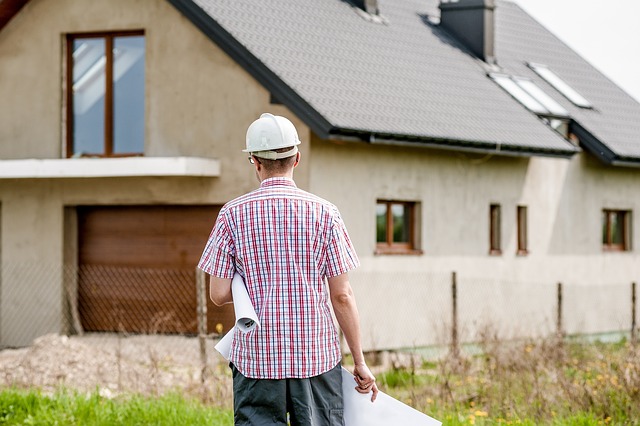Regularly maintaining and inspecting a home's roofing and siding is essential for long-term structural integrity, safety, and visual appeal. Visual checks should be complemented by monitoring for subtle signs of wear like shingle granule loss or algae growth, which can compromise the roof's function. Prompt action on these signs ensures timely repairs or protective measures. Siding condition is equally critical; it serves as a barrier against weather and pests, and maintaining its integrity is key to preserving energy efficiency and the home's exterior look. Both roofing and siding require tailored maintenance strategies that consider material resilience and regional climates within the broader context of Home Repair and Maintenance. Homeowners should opt for durable materials like vinyl or fiber cement, which offer different benefits depending on the home's character and local weather patterns. Regular cleaning and timely professional assessments are crucial for early detection of issues, ensuring that repairs align with industry best practices to maximize the property's value and longevity. Consulting experts for personalized advice on material selection and repair methods is recommended to effectively manage home upkeep.
When it comes to maintaining a safe and comfortable home environment, the integrity of your roofing and siding plays a pivotal role. This article delves into the essentials of evaluating roofing repairs, exploring robust siding repair strategies, and integrating these fixes into a comprehensive home repair and maintenance plan. Whether you’re tackling leaks or revitalizing your home’s facade, understanding the materials, techniques, and best practices is key to safeguarding your property against the elements. Dive into the intricacies of preserving your abode with insights tailored for long-term residential upkeep.
- Evaluating the Necessity of Roofing Repairs: Identifying Signs and Implementing Effective Solutions
- Siding Repair Strategies: Material Options, Techniques, and Maintenance Best Practices
- Comprehensive Home Repair and Maintenance: Integrating Roofing and Siding Fixes into Your Long-Term Plan
Evaluating the Necessity of Roofing Repairs: Identifying Signs and Implementing Effective Solutions

When homeowners consider the upkeep of their property, roofing repairs often rank among the most critical maintenance tasks. Regular evaluations are essential to identify potential issues before they escalate into costly problems. Visual inspections from the ground can reveal obvious signs such as missing shingles, cracked tiles, or visible daylight emanating from the attic, indicating compromised roof integrity. These signs warrant a closer inspection. Homeowners should also be vigilant for less conspicuous indicators like worn granules on asphalt shingles, which protect against UV rays and water intrusion, or the presence of dark streaks or algae that can diminish the lifespan of roofing materials. Identifying these issues promptly allows for effective solutions to be implemented, such as targeted repairs, full roof replacement, or the application of protective coatings. Professional assessment is recommended for a thorough understanding of the scope and urgency of the repair work required. In conjunction with roofing repairs, assessing the condition of siding is equally important. Siding serves as a barrier against weather elements and pests, contributing significantly to home energy efficiency. Any noticeable warping, cracking, or peeling should be addressed to maintain the structural integrity and aesthetic appeal of the home’s exterior. Home repair and maintenance are interconnected; what begins with a leaky roof can lead to more extensive damage if not promptly attended to. Therefore, proactive and diligent care of both roofing and siding is crucial for the long-term health and value of any residential property.
Siding Repair Strategies: Material Options, Techniques, and Maintenance Best Practices

When addressing siding repair strategies, it’s crucial to consider the variety of materials available, as each offers unique properties and maintenance requirements. Vinyl siding, for instance, is a popular choice due to its durability, low maintenance, and versatile design options. It resists warping, cracking, and fading, making it an ideal solution for homeowners seeking longevity without frequent upkeep. For homes with more substantial character or those in areas prone to severe weather, fiber cement siding is a robust alternative that mimics the appearance of wood while providing superior strength and resistance to moisture and fire. Wood siding, while requiring more intensive maintenance, offers a natural look and can be refinished or repaired to maintain its aesthetic appeal for years to come.
Maintenance best practices for siding repair emphasize regular inspections to catch issues early, preventing minor damages from becoming major ones. Homeowners should clean their siding annually using gentle cleaning solutions to remove dirt, pollen, and other debris that can affect the material’s integrity over time. For instance, vinyl siding may be wiped down with a soft brush and soapy water, while wood requires more specific attention, such as staining and sealing to protect against the elements. Professional repair services should be enlisted for any significant damage or when tackling complex repairs that exceed DIY expertise. By adhering to these maintenance best practices, homeowners can ensure their siding remains in top condition, contributing to the overall durability and appearance of their property.
Comprehensive Home Repair and Maintenance: Integrating Roofing and Siding Fixes into Your Long-Term Plan

Regular home repair and maintenance are pivotal for maintaining a structure’s integrity, safety, and aesthetic appeal. As part of this regimen, integrating roofing and siding repairs into your long-term plan is not just a matter of upkeep but an investment in your home’s longevity. Roofing systems protect your home from the elements, while siding shields it from environmental wear and tear. A comprehensive approach to these repairs involves proactive inspections to catch issues early, thus preventing more costly interventions down the line.
The materials and techniques used for roofing and siding repair should align with the latest industry standards to ensure durability and performance. Homeowners should consider long-lasting, sustainable options that can withstand local climate conditions and reduce long-term maintenance demands. By incorporating these repairs into a well-thought-out home repair and maintenance schedule, you not only safeguard your property’s value but also create a more comfortable living environment for years to come. Regular assessments by certified professionals can guide the selection of appropriate materials and strategies, ensuring that your roofing and siding remain robust against the test of time.
When addressing home repair and maintenance, it’s crucial to recognize the significance of robust roofing and siding upkeep. This article has outlined key strategies for evaluating roof integrity and implementing effective solutions, as well as exploring various siding repair techniques and materials. Integrating these elements into a comprehensive long-term plan not only fortifies your home’s defenses against the elements but also enhances its overall longevity and value. By staying vigilant and proactive with repairs, homeowners can ensure their property remains safe and aesthetically pleasing for years to come.
